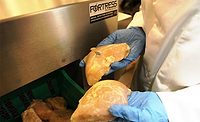Food Safety: Color contributes to safe, efficient food production

Good planning is key to an effective color-coding program and proper usage of corresponding plant tools. In this example, red indicates receiving/raw materials; blue indicates QC lab/test kitchen; yellow and purple indicate processing areas; gray indicates employee lounge; white indicates restroom; green indicates office space; and orange indicates the warehousing area. Source: Carlisle Sanitary Products.

Clothing can be made to match the tools. Source: Remco.

Perfex brushes and brooms are made using an injection-molding process that melts polypropylene bristles to a polypropylene brush block, creating a one-piece unit that prevents fiber fallout and eliminates bacteria pockets. Source: Perfex.

Tools and their shadows are displayed on a pegboard. Shadow images are produced by the Mobile In-House Sign Shop from Visual Workplace Inc. Source: Visual Workplace.

Brushes and other cleaning tools and their shadows are shown inside a major US bottled water plant. Source: Visual Workplace.



